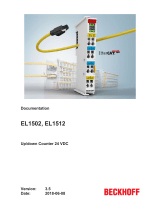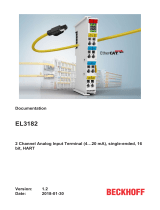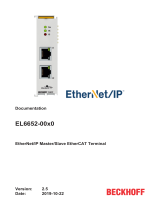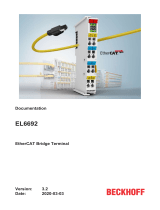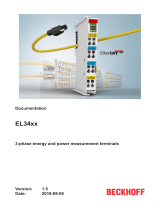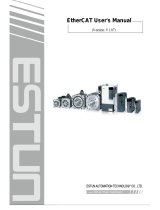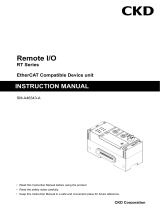Page is loading ...

Documentation
EL6731
Master/Slave terminal for PROFIBUS
2.8
2020-03-16
Version:
Date:


Table of contents
EL6731 3Version: 2.8
Table of contents
1 Foreword ....................................................................................................................................................5
1.1 Notes on the documentation..............................................................................................................5
1.2 Safety instructions .............................................................................................................................6
1.3 Documentation issue status ..............................................................................................................7
1.4 Version identification of EtherCAT devices .......................................................................................7
1.4.1 Beckhoff Identification Code (BIC)................................................................................... 12
2 Product overview.....................................................................................................................................14
2.1 Introduction......................................................................................................................................14
2.2 Technical data .................................................................................................................................15
3 Mounting and wiring................................................................................................................................16
3.1 Instructions for ESD protection........................................................................................................16
3.2 Recommended mounting rails.........................................................................................................16
3.3 Installation positions ........................................................................................................................17
3.4 Mounting and demounting - terminals with traction lever unlocking ................................................18
3.5 Mounting and demounting - terminals with front unlocking .............................................................20
3.6 Positioning of passive Terminals .....................................................................................................22
3.7 PROFIBUS cabling..........................................................................................................................22
3.8 PROFIBUS Connection ...................................................................................................................24
3.9 ATEX - Special conditions (extended temperature range) ..............................................................26
3.10 ATEX Documentation ......................................................................................................................27
3.11 UL notice .........................................................................................................................................27
4 Basics communication ...........................................................................................................................28
4.1 EtherCAT basics..............................................................................................................................28
4.2 General notes for setting the watchdog...........................................................................................28
4.3 EtherCAT State Machine.................................................................................................................30
4.4 CoE Interface...................................................................................................................................32
5 Parameterization and commissioning...................................................................................................37
5.1 EL6731 - PROFIBUS master terminal.............................................................................................37
5.1.1 PROFIBUS protocols....................................................................................................... 37
5.1.2 PROFIBUS DP ................................................................................................................ 38
5.1.3 PROFIBUS MC................................................................................................................ 40
5.1.4 Synchronization ............................................................................................................... 41
5.1.5 ADS (acyclic services) ..................................................................................................... 42
5.1.6 TwinCAT (2.1x) System Manager.................................................................................... 53
5.1.7 Operation of PROFIdrive MC drives .............................................................................. 101
5.1.8 Diagnostics and error description .................................................................................. 114
5.1.9 Slave Prioritization/Multiple DP Cycles.......................................................................... 129
5.2 EL6731-0010 - PROFIBUS slave terminal ....................................................................................130
6 EtherCAT communication EL6731-00x0..............................................................................................134
6.1 PROFIBUS master ........................................................................................................................134
6.1.1 State machine................................................................................................................ 134
6.1.2 Synchronization ............................................................................................................. 138
6.1.3 Object description and parameterization ....................................................................... 142

Table of contents
EL67314 Version: 2.8
6.2 PROFIBUS slave...........................................................................................................................160
6.2.1 State machine................................................................................................................ 160
6.2.2 Object description and parameterization ....................................................................... 164
7 Appendix ................................................................................................................................................172
7.1 EtherCAT AL Status Codes...........................................................................................................172
7.2 Firmware compatibility...................................................................................................................172
7.3 Firmware Update EL/ES/EM/ELM/EPxxxx ....................................................................................173
7.3.1 Device description ESI file/XML..................................................................................... 174
7.3.2 Firmware explanation .................................................................................................... 177
7.3.3 Updating controller firmware *.efw................................................................................. 178
7.3.4 FPGA firmware *.rbf....................................................................................................... 179
7.3.5 Simultaneous updating of several EtherCAT devices.................................................... 183
7.4 Support and Service ......................................................................................................................184

Foreword
EL6731 5Version: 2.8
1 Foreword
1.1 Notes on the documentation
Intended audience
This description is only intended for the use of trained specialists in control and automation engineering who
are familiar with the applicable national standards.
It is essential that the documentation and the following notes and explanations are followed when installing
and commissioning these components.
It is the duty of the technical personnel to use the documentation published at the respective time of each
installation and commissioning.
The responsible staff must ensure that the application or use of the products described satisfy all the
requirements for safety, including all the relevant laws, regulations, guidelines and standards.
Disclaimer
The documentation has been prepared with care. The products described are, however, constantly under
development.
We reserve the right to revise and change the documentation at any time and without prior announcement.
No claims for the modification of products that have already been supplied may be made on the basis of the
data, diagrams and descriptions in this documentation.
Trademarks
Beckhoff
®
, TwinCAT
®
, EtherCAT
®
, EtherCATG
®
, EtherCATG10
®
, EtherCATP
®
, SafetyoverEtherCAT
®
,
TwinSAFE
®
, XFC
®
, XTS
®
and XPlanar
®
are registered trademarks of and licensed by Beckhoff Automation
GmbH. Other designations used in this publication may be trademarks whose use by third parties for their
own purposes could violate the rights of the owners.
Patent Pending
The EtherCAT Technology is covered, including but not limited to the following patent applications and
patents: EP1590927, EP1789857, EP1456722, EP2137893, DE102015105702 with corresponding
applications or registrations in various other countries.
EtherCAT
®
is registered trademark and patented technology, licensed by Beckhoff Automation GmbH,
Germany.
Copyright
© Beckhoff Automation GmbH & Co. KG, Germany.
The reproduction, distribution and utilization of this document as well as the communication of its contents to
others without express authorization are prohibited.
Offenders will be held liable for the payment of damages. All rights reserved in the event of the grant of a
patent, utility model or design.

Foreword
EL67316 Version: 2.8
1.2 Safety instructions
Safety regulations
Please note the following safety instructions and explanations!
Product-specific safety instructions can be found on following pages or in the areas mounting, wiring,
commissioning etc.
Exclusion of liability
All the components are supplied in particular hardware and software configurations appropriate for the
application. Modifications to hardware or software configurations other than those described in the
documentation are not permitted, and nullify the liability of Beckhoff Automation GmbH & Co. KG.
Personnel qualification
This description is only intended for trained specialists in control, automation and drive engineering who are
familiar with the applicable national standards.
Description of instructions
In this documentation the following instructions are used.
These instructions must be read carefully and followed without fail!
DANGER
Serious risk of injury!
Failure to follow this safety instruction directly endangers the life and health of persons.
WARNING
Risk of injury!
Failure to follow this safety instruction endangers the life and health of persons.
CAUTION
Personal injuries!
Failure to follow this safety instruction can lead to injuries to persons.
NOTE
Damage to environment/equipment or data loss
Failure to follow this instruction can lead to environmental damage, equipment damage or data loss.
Tip or pointer
This symbol indicates information that contributes to better understanding.

Foreword
EL6731 7Version: 2.8
1.3 Documentation issue status
Version Comment
2.8 • Update structure
2.7 • Update chapter “ADS Error Codes”
• Update structure
• Update revision status
2.6 • Update chapter "Technical data"
2.5 • Update chapter “DP State of slaves”
• Update structure
• Update revision status
2.4 • Update chapter “Master diagnostic data”
• Update structure
• Update revision status
2.3 • Update chapter “Introduction”
• Update chapter “LED description”
• Update chapter “PROFIBUS Connection”
2.2 • Update chapter "PROFIBUS protocols"
• Update chapter "ADS interface"
• "S5-FDL communication" chapter removed
2.1 • Update chapter "Technical data"
• Update chapter "ADS interface"
• Addenda chapter “ESD protection”
• Update revision status
• Update structure
2.0 • Migration
1.7 • Update chapter "Technical data"
• Update chapter "Firmware compatibility"
• Update structure
1.6 • Update chapter "Technical data"
• Update chapter "Object description and parameterization"
• Update structure
1.5 • "Operation of PROFIDrive MC drives" chapter added
1.4 • "FDL interface" chapter added
1.3 • Technical data added, object description amended
1.2 • Technical data corrected
1.1 • Technical data corrected
1.0 • Revision, technical data amended
0.1 • Preliminary version for internal use
1.4 Version identification of EtherCAT devices
Designation
A Beckhoff EtherCAT device has a 14-digit designation, made up of
• family key
• type
• version

Foreword
EL67318 Version: 2.8
• revision
Example Family Type Version Revision
EL3314-0000-0016 EL terminal
(12 mm, non-
pluggable connection
level)
3314 (4-channel thermocouple
terminal)
0000 (basic type) 0016
ES3602-0010-0017 ES terminal
(12 mm, pluggable
connection level)
3602 (2-channel voltage
measurement)
0010 (high-
precision version)
0017
CU2008-0000-0000 CU device 2008 (8-port fast ethernet switch) 0000 (basic type) 0000
Notes
• The elements mentioned above result in the technical designation. EL3314-0000-0016 is used in the
example below.
• EL3314-0000 is the order identifier, in the case of “-0000” usually abbreviated to EL3314. “-0016” is the
EtherCAT revision.
• The order identifier is made up of
- family key (EL, EP, CU, ES, KL, CX, etc.)
- type (3314)
- version (-0000)
• The revision -0016 shows the technical progress, such as the extension of features with regard to the
EtherCAT communication, and is managed by Beckhoff.
In principle, a device with a higher revision can replace a device with a lower revision, unless specified
otherwise, e.g. in the documentation.
Associated and synonymous with each revision there is usually a description (ESI, EtherCAT Slave
Information) in the form of an XML file, which is available for download from the Beckhoff web site.
From 2014/01 the revision is shown on the outside of the IP20 terminals, see Fig. “EL5021 EL terminal,
standard IP20 IO device with batch number and revision ID (since 2014/01)”.
• The type, version and revision are read as decimal numbers, even if they are technically saved in
hexadecimal.
Identification number
Beckhoff EtherCAT devices from the different lines have different kinds of identification numbers:
Production lot/batch number/serial number/date code/D number
The serial number for Beckhoff IO devices is usually the 8-digit number printed on the device or on a sticker.
The serial number indicates the configuration in delivery state and therefore refers to a whole production
batch, without distinguishing the individual modules of a batch.
Structure of the serial number: KKYYFFHH
KK - week of production (CW, calendar week)
YY - year of production
FF - firmware version
HH - hardware version
Example with
Ser. no.: 12063A02: 12 - production week 12 06 - production year 2006 3A - firmware version 3A 02 -
hardware version 02
Exceptions can occur in the IP67 area, where the following syntax can be used (see respective device
documentation):
Syntax: D ww yy x y z u
D - prefix designation
ww - calendar week
yy - year

Foreword
EL6731 9Version: 2.8
x - firmware version of the bus PCB
y - hardware version of the bus PCB
z - firmware version of the I/O PCB
u - hardware version of the I/O PCB
Example: D.22081501 calendar week 22 of the year 2008 firmware version of bus PCB: 1 hardware version
of bus PCB: 5 firmware version of I/O PCB: 0 (no firmware necessary for this PCB) hardware version of I/O
PCB: 1
Unique serial number/ID, ID number
In addition, in some series each individual module has its own unique serial number.
See also the further documentation in the area
• IP67: EtherCAT Box
• Safety: TwinSafe
• Terminals with factory calibration certificate and other measuring terminals
Examples of markings
Fig.1: EL5021 EL terminal, standard IP20 IO device with serial/ batch number and revision ID (since
2014/01)
Fig.2: EK1100 EtherCAT coupler, standard IP20 IO device with serial/ batch number

Foreword
EL673110 Version: 2.8
Fig.3: CU2016 switch with serial/ batch number
Fig.4: EL3202-0020 with serial/ batch number 26131006 and unique ID-number 204418
Fig.5: EP1258-00001 IP67 EtherCAT Box with batch number/ date code 22090101 and unique serial
number 158102
Fig.6: EP1908-0002 IP67 EtherCAT Safety Box with batch number/ date code 071201FF and unique serial
number 00346070

Foreword
EL6731 11Version: 2.8
Fig.7: EL2904 IP20 safety terminal with batch number/ date code 50110302 and unique serial number
00331701
Fig.8: ELM3604-0002 terminal with unique ID number (QR code) 100001051 and serial/ batch number
44160201

Foreword
EL673112 Version: 2.8
1.4.1 Beckhoff Identification Code (BIC)
The Beckhoff Identification Code (BIC) is increasingly being applied to Beckhoff products to uniquely identify
the product. The BIC is represented as a Data Matrix Code (DMC, code scheme ECC200), the content is
based on the ANSI standard MH10.8.2-2016.
Fig.9: BIC as data matrix code (DMC, code scheme ECC200)
The BIC will be introduced step by step across all product groups.
Depending on the product, it can be found in the following places:
• on the packaging unit
• directly on the product (if space suffices)
• on the packaging unit and the product
The BIC is machine-readable and contains information that can also be used by the customer for handling
and product management.
Each piece of information can be uniquely identified using the so-called data identifier
(ANSIMH10.8.2-2016). The data identifier is followed by a character string. Both together have a maximum
length according to the table below. If the information is shorter, spaces are added to it. The data under
positions 1 to 4 are always available.
The following information is contained:

Foreword
EL6731 13Version: 2.8
Item
no.
Type of
information
Explanation Data
identifier
Number of digits
incl. data identifier
Example
1 Beckhoff order
number
Beckhoff order number 1P 8 1P072222
2 Beckhoff Traceability
Number (BTN)
Unique serial number,
see note below
S 12 SBTNk4p562d7
3 Article description Beckhoff article
description, e.g.
EL1008
1K 32 1KEL1809
4 Quantity Quantity in packaging
unit, e.g. 1, 10, etc.
Q 6 Q1
5 Batch number Optional: Year and week
of production
2P 14 2P401503180016
6 ID/serial number Optional: Present-day
serial number system,
e.g. with safety products
51S 12 51S678294104
7 Variant number Optional: Product variant
number on the basis of
standard products
30P 32 30PF971, 2*K183
...
Further types of information and data identifiers are used by Beckhoff and serve internal processes.
Structure of the BIC
Example of composite information from item 1 to 4 and 6. The data identifiers are marked in red for better
display:
BTN
An important component of the BIC is the Beckhoff Traceability Number (BTN, item no.2). The BTN is a
unique serial number consisting of eight characters that will replace all other serial number systems at
Beckhoff in the long term (e.g. batch designations on IO components, previous serial number range for
safety products, etc.). The BTN will also be introduced step by step, so it may happen that the BTN is not yet
coded in the BIC.
NOTE
This information has been carefully prepared. However, the procedure described is constantly being further
developed. We reserve the right to revise and change procedures and documentation at any time and with-
out prior notice. No claims for changes can be made from the information, illustrations and descriptions in
this information.

Product overview
EL673114 Version: 2.8
2 Product overview
2.1 Introduction
Fig.10: EL6731
Master and slave terminals for PROFIBUS
The master and slave terminals for PROFIBUS correspond to the FC3101 PCI card from Beckhoff. Thanks
to the connection via Ethernet, no PCI slots are required in the PC.
The EL6731 can run the PROFIBUS protocol with all features; in the EtherCAT Terminal network it enables
integration of any Profibus devices. Thanks to the in-house development of the PROFIBUS chip, the
terminals are equipped with the latest version of the PROFIBUS technology – including high-precision
isochronous mode for axis control and extended diagnostic options. This masters are the only ones that
support different poll rates for the slaves.
Features:
• Cycle times from 200 µs are possible
• PROFIBUS DP, PROFIBUS DP-V1, PROFIBUS DP-V2
• Master, slave and Profibus monitor up to 12 Mbit/s
• Powerful parameter and diagnostics interfaces
• Error management freely configurable for each bus device
• It is possible to read the bus configuration and automatically assign the "GSD" files

Product overview
EL6731 15Version: 2.8
2.2 Technical data
Technical data EL6731-0000 EL6731-0010
Bus system PROFIBUS DP (standard),
PROFIBUS DP-V1 (Cl. 1+2: acyclic services, alarms),
PROFIBUS DP-V2, PROFIBUS MC (equidistance)
Version Master Slave
Number of fieldbus channels 1
Data transfer rate 9.6kbaud to 12Mbaud
Bus interface 1 x D-Sub socket, 9-pin, galvanically isolated
Bus nodes maximum 125 slaves with up to 244 bytes input, output,
parameter, configuration or diagnostic data per slave
Cycle time Differing DP cycle times per slave are possible using the CDL
concept
Process image Sum max.: 1.4kbyte input and 1.4kbyte output data
Diagnostics Status LEDs
Power supply via the E-bus
Current consumption via E-bus typ. 350 mA
Electrical isolation 500 V (E-bus/Profibus)
Configuration with TwinCAT System Manager
Weight approx. 70 g
Permissible ambient temperature range
during operation
-25 °C ... +60 °C (extended Temperature range) (for
EL6731-0010 from Hardware 17)
Permissible ambient temperature range
during storage
-40 °C ... +85 °C
Permissible relative humidity 95%, no condensation
Dimensions (W x H x D) approx. 26 mm x 100 mm x 52 mm (width aligned: 23 mm)
Mounting [}18]
on 35 mm mounting rail conforms to EN 60715
Vibration/shock resistance conforms to EN 60068-2-6 / EN 60068-2-27
EMC immunity/emission conforms to EN 61000-6-2 / EN 61000-6-4
Protection class IP20
Installation position variable
Approval CE
ATEX [}26]
cULus [}27]

Mounting and wiring
EL673116 Version: 2.8
3 Mounting and wiring
3.1 Instructions for ESD protection
NOTE
Destruction of the devices by electrostatic discharge possible!
The devices contain components at risk from electrostatic discharge caused by improper handling.
• Please ensure you are electrostatically discharged and avoid touching the contacts of the device directly.
• Avoid contact with highly insulating materials (synthetic fibers, plastic film etc.).
• Surroundings (working place, packaging and personnel) should by grounded probably, when handling
with the devices.
• Each assembly must be terminated at the right hand end with an EL9011 or EL9012 bus end cap, to en-
sure the protection class and ESD protection.
Fig.11: Spring contacts of the Beckhoff I/O components
3.2 Recommended mounting rails
Terminal Modules und EtherCAT Modules of KMxxxx and EMxxxx series, same as the terminals of the
EL66xx and EL67xx series can be snapped onto the following recommended mounting rails:
• DIN Rail TH35-7.5 with 1mm material thickness (according to EN60715)
• DIN Rail TH35-15 with 1,5mm material thickness
Pay attention to the material thickness of the DIN Rail
Terminal Modules und EtherCAT Modules of KMxxxx and EMxxxx series, same as the terminals of
the EL66xx and EL67xx seriesdoes not fit to the DIN Rail TH35-15 with 2,2 to 2,5mm material
thickness (according to EN60715)!

Mounting and wiring
EL6731 17Version: 2.8
3.3 Installation positions
NOTE
Constraints regarding installation position and operating temperature range
Please refer to the technical data for a terminal to ascertain whether any restrictions regarding the installa-
tion position and/or the operating temperature range have been specified. When installing high power dissi-
pation terminals ensure that an adequate spacing is maintained between other components above and be-
low the terminal in order to guarantee adequate ventilation!
Optimum installation position (standard)
The optimum installation position requires the mounting rail to be installed horizontally and the connection
surfaces of the EL/KL terminals to face forward (see Fig. “Recommended distances for standard installation
position”). The terminals are ventilated from below, which enables optimum cooling of the electronics through
convection. "From below" is relative to the acceleration of gravity.
Fig.12: Recommended distances for standard installation position
Compliance with the distances shown in Fig. “Recommended distances for standard installation position” is
recommended.
Other installation positions
All other installation positions are characterized by different spatial arrangement of the mounting rail - see
Fig “Other installation positions”.
The minimum distances to ambient specified above also apply to these installation positions.

Mounting and wiring
EL673118 Version: 2.8
Fig.13: Other installation positions
3.4 Mounting and demounting - terminals with traction
lever unlocking
The terminal modules are fastened to the assembly surface with the aid of a 35 mm mounting rail (e.g.
mounting rail TH 35-15).
Fixing of mounting rails
The locking mechanism of the terminals and couplers extends to the profile of the mounting rail. At
the installation, the locking mechanism of the components must not come into conflict with the fixing
bolts of the mounting rail. To mount the recommended mounting rails under the terminals and cou-
plers, you should use flat mounting connections (e.g. countersunk screws or blind rivets).
WARNING
Risk of electric shock and damage of device!
Bring the bus terminal system into a safe, powered down state before starting installation, disassembly or
wiring of the Bus Terminals!
Mounting
• Fit the mounting rail to the planned assembly location.

Mounting and wiring
EL6731 19Version: 2.8
and press (1) the terminal module against the mounting rail until it latches in place on the mounting
rail (2).
• Attach the cables.
Demounting
• Remove all the cables. Thanks to the KM/EM connector, it is not necessary to remove all the cables
separately for this, but for each KM/EM connector simply undo 2 screws so that you can pull them off
(fixed wiring)!
• Lever the unlatching hook on the left-hand side of the terminal module upwards with a screwdriver (3).
As you do this
◦ an internal mechanism pulls the two latching lugs (3a) from the top hat rail back into the terminal
module,
◦ the unlatching hook moves forwards (3b) and engages

Mounting and wiring
EL673120 Version: 2.8
• In the case 32 and 64 channel terminal modules (KMxxx4 and KMxxx8 or EMxxx4 and EMxxx8) you
now lever the second unlatching hook on the right-hand side of the terminal module upwards in the
same way.
• Pull (4) the terminal module away from the mounting surface.
3.5 Mounting and demounting - terminals with front
unlocking
The terminal modules are fastened to the assembly surface with the aid of a 35 mm mounting rail (e.g.
mounting rail TH 35-15).
Fixing of mounting rails
The locking mechanism of the terminals and couplers extends to the profile of the mounting rail. At
the installation, the locking mechanism of the components must not come into conflict with the fixing
bolts of the mounting rail. To mount the recommended mounting rails under the terminals and cou-
plers, you should use flat mounting connections (e.g. countersunk screws or blind rivets).
WARNING
Risk of electric shock and damage of device!
Bring the bus terminal system into a safe, powered down state before starting installation, disassembly or
wiring of the Bus Terminals!
Mounting
• Fit the mounting rail to the planned assembly location.
/
